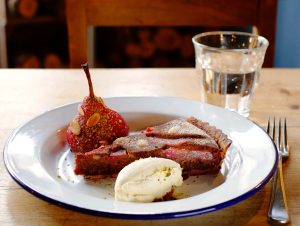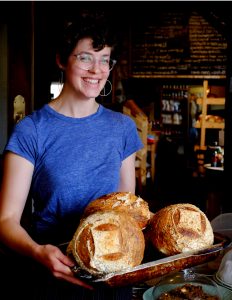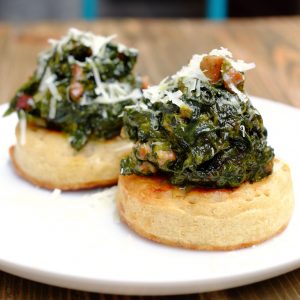The Welsh poet Dylan Thomas described Laugharne, on Carmarthenshire’s Taf estuary, as a “far, forgetful, important place of herons pubs, mud, cockles… and human, often all too human, beings”. Today Laugharne (pronounced Larn) may be merely a stopping off point for many who stampede westwards to Pembrokeshire, but for those who linger, it remains as captivating as it was in Thomas’s days. Brown’s Hotel, where he drank (and drank), is still its main watering hole; the boathouse where he lived still perches on its eastern cliffs, now open to the public as a museum and café; and locals continue to hunt for cockles in the tidal mud.
Unlike Thomas, I’m in search of food, not booze. At lunchtime, bowls of cawl (vegetable soup) and plates of bara brith are to be had at the café in Dylan’s boathouse, or in the Ferryman deli along from Brown’s. In the evening, however, I book in at The Cors, a boho Italianate villa that’s run by ex-artist Nick Priestland (his artworks pepper the walls). “Cors actually means ‘bog’, which might seem an unlikely place to build a villa,” quips Nick, as I settle down to a candlelit dinner: rack of Welsh salt-marsh lamb with a rosemary garlic crust, the pink-tickled meat sourced from Eynon’s butchers in nearby St Clears.
Inland, Carmarthen, the county’s ancient capital, brings another crumbling castle and two meaty producers: Neil Rose from Rhosyn Farm, who sells home-reared meats at an outdoor stall and, at Carmarthen’s indoor food market, Chris and Anne Rees, who air-dry Carmarthen Ham. The Rees family has been curing ham for five generations but only recently got it registered as a protected name. Salty, sweet and silky, it’s as good as parma ham – although if the Italian stuff is what you’re after, head to Carmarthen’s continental-style Blasus Deli, also known for its standout cheese counter; local must-trys include Hafod cheddar, made just under 30 miles north, near Lampeter.
You’re spoiled for cafés and restaurants, too. At Karm’en Kafé, off Nott Square, Polish owner Kasia Strykowska sells thin-crust pizzas made with her own dough and home-baked, filled rolls as well as lunch specials (potato and onion pancakeswith soured cream; asparagus, chicken and cauliflower tart), cakes (lemon polenta, cherry and rose cheesecake) and pop up Friday suppers.
 For atmosphere and ethos, head to aptly named The Warren, a shabby-chic, crowd-funded café-restaurant which not only gets most of its ingredients direct from small local producers but also grows its own salads and herbs. Menus are simple, perhaps a beetroot and Perl Las blue cheese quiche or a dal, followed by equally unpretentious but well-executed desserts such as chocolate, almond and pear tart.
For atmosphere and ethos, head to aptly named The Warren, a shabby-chic, crowd-funded café-restaurant which not only gets most of its ingredients direct from small local producers but also grows its own salads and herbs. Menus are simple, perhaps a beetroot and Perl Las blue cheese quiche or a dal, followed by equally unpretentious but well-executed desserts such as chocolate, almond and pear tart.
At the opposite end of the scale, The Café at No4, across the square, offers fine dining at reasonable prices: £30-35 for a three-course dinner. Head chef Andrew Luck trained under John Williams at Claridge’s, and his classical training shines most brightly in dishes such as 12-hour-braised shin of beef with cep tortellini and an intensely flavoured sauce Bordelaise, or a dense, sweet chocolate crémeux dessert.
I drive through Carmarthenshire’s plush green hills in search of small food producers. But I’m unprepared for the disrupted setting where millennial Willy Wonka, Liam Burgess, is making his NomNom chocolate: an abandoned farm where another chocolate-maker once functioned. Twenty-four-year-old Liam says he’s had chocolate in the blood since growing up next to the Cadbury’s factory at Bournville. Launched with a grant from the Prince’s Trust, NomNom produces bars with flavours ranging from Halen Môn salt to orange marmalade.
Eventually Burgess hopes to crowd-fund the company into a confectioner with a conscience. At present, though, the place is largely a ruin; the fact the young team produce chocolate there at all feels like alchemy. “We’re moving from dystopia to utopia,” Burgess tells me as we tiptoe past a dark derelict room entitled ‘Beating and Whipping’.
Next stop is Caws Cenarth on Carmarthenshire’s boundary with Ceredigion, where farmer’s wife Thelma Adams started making cheese in her farmhouse kitchen in 1987. She rescued artisan caerphilly from oblivion, then invented brie-style Perl Wen and rind-washed Golden Cenarth. My favourite, though, is Perl Las, her punchy but creamy blue, which you can buy, with the other cheeses, in the on-site shop.
Heading back to Carmarthen, then east along the Towy, I stop for lunch at Y Polyn, run by Mark and Susan Manson. One of the UK’s first true gastropubs, it’s still busy, despite an out-of-the-way location. Not least thanks to Susan’s legendary fish soup (on the menu for the 14 years the couple have been there) or her nutmeggy custard tart. From March onwards the draw is pink-fleshed sewin (sea trout), line-caught from coracles on Carmarthenshire’s Teifi and Towy estuaries.

Journalist and chef Simon Wright once co-ran Y Polyn with the Mansons but now owns Wright’s Food Emporium a few miles east. Its roadside location and plain exterior are so at odds with what’s inside – pork belly Cubano baps and coconut milk cake in the café, Charcutier native-breed sausages in the shop – that stepping through the door really is like entering a kind of gastronomic Narnia. There’s a wine corner, selling natural wines from small producers (you can also refill bottles by the tap, from two industrial-looking wooden barrels), plus family-sized pies of the day (they’ll decant them into your own pie tin if you want to pass them off as your own), cheeses, beers, local coffee, chutney, Welsh cider and fresh bread.
There’s more booze and bonhomie 10 minutes’ drive east at the Ginhaus Deli in Llandeilo (also home to the first of only two TOAST archive shops; the fashion brand first set up stall in this small market town). As the name suggests, Ginhaus stocks more than 400 gins, around 10 of which are Welsh, including Carmarthenshire’s Dà Mhìle, which it garnishes with herbs from nearby Aberglasney Gardens. This is also the place to pick up some nutty Coaltown coffee, produced in neighbouring Ammanford, which cannily switched to roasting coffee after its coalpits closed. Enjoy a sandwich, or a platter of antipasti or fresh crab, in the deli’s café (on Fridays there’s handmade pizza, too).
Carnivores should head to the National Trust-owned Dinefwr Park, famed for its striking, 100-year-old herd of White Park cattle and also for its venison, which you can buy frozen in Dinefwr’s shop or fresh at Cooper the Butchers in town. Other Llandeilo must-visits include Peppercorn kitchen shop, where you can pick up anything from a game pie mould to a Wüsthof kitchen knife, and occasionally catch visiting food writers talking about their latest book.
 Further east, still, is Llandovery, whose streets are spiked with ancient inns and regular livestock auctions. I stroll past its terraces of rainbow-coloured houses to The Old Printing Office, a shop and gallery with a café tucked away in a covered courtyard, serving owner Caroline Whitney’s local twist on modern comfort food.
Further east, still, is Llandovery, whose streets are spiked with ancient inns and regular livestock auctions. I stroll past its terraces of rainbow-coloured houses to The Old Printing Office, a shop and gallery with a café tucked away in a covered courtyard, serving owner Caroline Whitney’s local twist on modern comfort food.
Using milk, cream and butter from nearby Gwenlas farm and veg from Iechyd Da, a few doors down, the café plays to local strengths with home-cooked quiches, open sandwiches (smashed pea and broad beans with chilli and mint) and a range of savoury homemade crumpets; Welsh rarebit with homemade blackberry ketchup, salmon from Black Mountains Smokery with scrambled eggs or a filling stack of warm spinach spun through with fried Welsh back bacon, cream, cheese and a grind or two of pepper.
I end back on the coast at tiny Llansteffan. In the old days, miners from eastern Carmarthenshire holidayed on the silver-sand beaches here, in the shadow of its ruined castle. They played music in a space in the woods called The Sticks, which also gave its name to the Inn at the Sticks, on Llansteffan’s main street.
The historic former hotel stood derelict until a couple of years ago, when ex-psychiatrist Ruth Stephens transformed it back into a simple inn with rooms. “My job hasn’t really changed,” she laughs. “I still listen to people’s woes and administer mind-altering substances.”
I stay there on my final night in Carmarthenshire, taking my time over dinner, at a scrubbed pine table by the woodburner. First, there’s a rich, gamey wood pigeon breast with puy lentils, then a main of braised pork belly. If they were to visit today those miners might be a bit nonplussed by the puy lentils, if not their meaty companions, but they’d be right at home among the conviviality of what has been returned not just to an inn but also to a community hub.
This article was originally published by Olive Magazine. All photographs by Clare Hargreaves.


